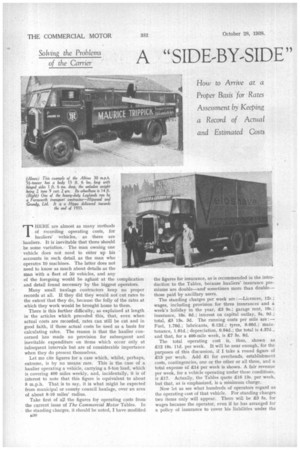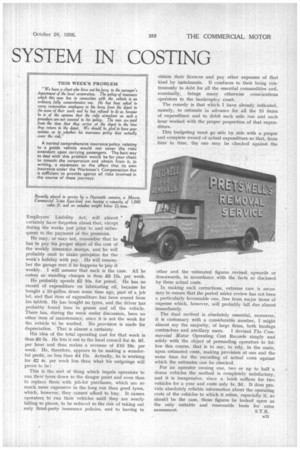A "SIDE-BY-SIDE"
Page 40

Page 41

If you've noticed an error in this article please click here to report it so we can fix it.
SYSTEM IN COSTING
How to Arrive at a Proper Basis 'for Rates Assessment by Keeping a Record of Actual and Estimated Costs THERE are almost as many methods of recording operating costs, for hauliers' vehicles, as there are hauliers. It is inevitable that there should be some variation.. The man owning one vehicle does not need to enter up his accounts in such detail as the man who operates 10 machines. The latter does not need to know as much about details as the man with a fleet of 50 vehicles, and any of the foregoing would be aghast at the complication and detail found necessary by the biggest operators.
Many small haulage contractors keep no proper records at all. If they did they would not cut rates to the extent that they do, because the folly of the rates at which they work would be brought home to them.
There is this further difficulty, as explained at length in the articles which preceded this, that, even when actual costs are recorded, rates can still be cut and in goad faith, if those actual costs be used as a basis for calculating rates. The reason is that the haulier concerned has made no provision for subsequent and inevitable expenditure on items which occur only at infrequent intervals but are of considerable importance when they do present themselves.
Let me cite figures for a case which, whilst, perhaps, extreme, is by no means rare. This is the case of a haulier operating a vehicle, carrying a 5-ton load, which is covering 400 miles weekly, and, incidentally, it is of interest to note that this figure is equivalent to about 8 m.p.h. That is to say, it is what might be expected from municipal or county council haulage, over an area of about 8-10 miles' radius.
Take first of all the figures for operating costs from the current issue of The Commercial Motor Tables. In the standing charges, it should be noted, I have modified
00 the figures for insurance, as is recommended in the introduction to the Tables, because hauliers' insurance premiums are double—and sometimes more than double— those paid by ancillary users.
The standing charges per week are :—Licences, 12s.; wages, including provision for three insurances and a week's holiday in the year, £3 9s.; garage rent, 10s.; insurance, 16s. 6d.; interest on capital outlay, 5s. 9d.; total, £5 13s. 3d. The running costs per mile are :— Fuel, 1.70c1.; lubricants, 0.12d.; tyres, 0.60d.; maintenance, 1.01d.; depreciation, 0.94d.: the total is 4.37d., and that, for a 400-mile week, is £7 5s. 8d.
The total operating cost is, thus, shown as £12 18s. lid, per week. It will be near enough, for the purposes of this discussion, if I take a round figure of £13 per week. Add 11 for overheads, establishment costs, contingencies, one or the other or all three, and a total expense of £14 per week is shown. A fair revenue per week, for a vehicle operating under these conditions, is £17. Actually, the Tables quote £16 13s. per week, but that, as is emphasized, is a minimum charge.
Now let us see what hundreds of operators regard as the operating cost of that vehicle. For standing charges two items only will appear. There will be £3 5s. for wages because the operator, even if he has arranged for a policy of insurance to cover his liabilities under the Employers' Liability Act, will almost certainly have forgotten about that, except during the weeks just prior to and subsequent to the payment of the premium.
He may, or may not, remember that he has to pay this proper share of the cost of the weekly insurance stamps, and he will probably omit to make provjsion for the week's holiday with pay. He will remember the garage rent if he happens to pay it weekly. I will assume that such is the case. All he enters as standing charges is thus £3 15s. per week.
He probably spends £2 10s. for petrol. He has no record of expenditure on lubricating oil, because he bought a 50-gallon drum some time ago, part of a job lot, and that item of expenditure has been erased from his tablets. He has bought no tyres, and the driver has probably found time to grease and oil the vehicle. There has, during the week under discussion, been no other item of maintenance, since it is not the week for the vehicle to be washed. No provision is made for depreciation. That is almost a certainty.
His idea of the total operating cost for that week is thus £6 55. He lets it out to the local council for 4s. 6d. per hour and thus makes a revenue of £10 16s. per week. He, therefore, appears to be making a wonderful profit, no less than £4 15s. Actually, he is working for £2 4s. per week less than what his outgoings will prove to be !
This is the sort of thing which impels operators to run their tyres down to the danger point and even then to replace them with job-lot purchases, which are so much more expensive in the long run than good tyres, which, however, they cannot afford to buy. It causes operators to run their vehicles until they are nearly falling to pieces, to be reduced to the risk of taking out only third-party insurance policies, and to having to
obtain their licences and pay other expenses of that kind by instalments. It conduces to their being continuously in debt for all the essential commodities and, eventually, brings many otherwise conscientious operators to the bankruptcy court.
The remedy is that which I have already indicated, namely, to estimate in advance for all the 10 items of expenditure and to debit each mile run and each hour worked with the proper proportion of that expenditure.
This budgeting must go side by side with a proper and complete record of 'actual expenditure so that, from time to time, the one may be checked against the other and the estimated figures revised upwards or downwards, in accordance with the facts as disclosed by these actual costs.
In making such corrections, extreme care is necessary to ensure that the period wider review has not been a particularly favourable one, free from major items of expense which, however, will probably fall due almost immediately.
The dual method is absolutely essential, moreover, it is customary with a considerable number, I might almost say the majority, of large firms, both haulage contractors and ancillary users. I devised The Commercial Motor Operating Cost Records simply and solely with the object of persuading operators to follow this course, that is to say, to rely, in the main, upon estimated costs, making provision at one and the same time for the 'recording of actual costs against which the estimates can be checked.
For an operator owning one, two or up to half a dozen vehicles the method is completely satisfactory, and it is inexpensive, since a book suffices for two vehicles for a year and costs only is. 3d. It does provide absolutely reliable information about the operating costs of the vehicles to which it refers, especially if. as should be the case, those figures be looked upon as the only suitable and reasonable basis for rates assessment. S.T.R.




















































































